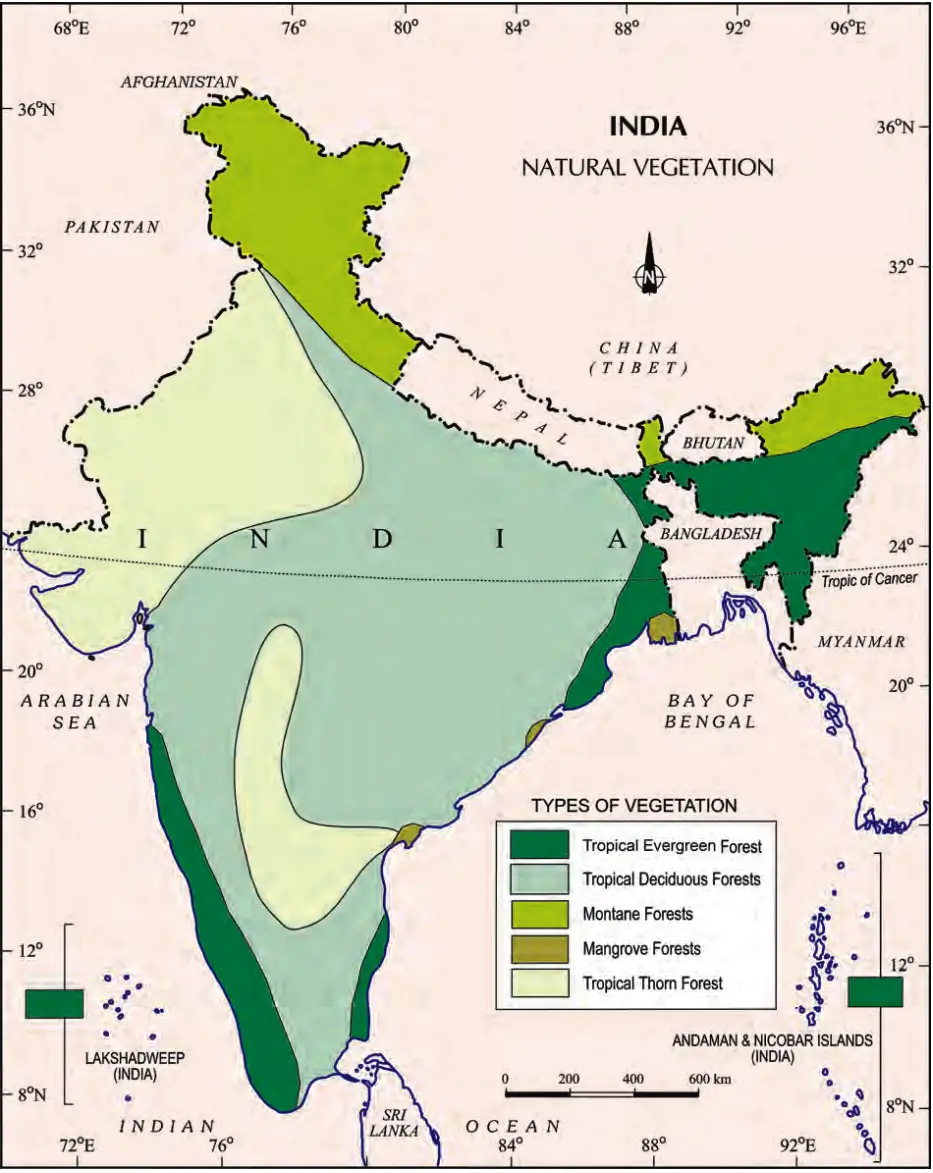Revision Notes of Geography Class 9 Chapter 5 Natural Vegetation and Wildlife
India is one of the 12 mega bio-diversity countries of the world. With about 47,000 plant species, India occupies tenth place in the world and fourth in Asia in plant diversity. There are about 15,000 flowering plants in India, which account for 6 per cent in the world’s total number of flowering plants. India also has approximately 90,000 species of animals, as well as a rich variety of fish in its fresh and marine waters.
Natural Vegetation
- It refers to a plant community, which has grown naturally without human aid and has been left undisturbed by humans for a long time. This is termed as a virgin vegetation.
- Cultivated crops and fruits, orchards form part of vegetation but not natural vegetation.
Important Terms
The virgin vegetation, which are purely Indian are known as endemic or indigenous species but those which have come from outside India are termed as exotic plants.
Flora: It is used to denote plants of a particular region or period.
Fauna: It is to denote the species of animals.
Factors Affecting Distribution of Flora and Fauna
Relief
- Land: The nature of land influences type of vegetation. The undulating and rough terrains are areas where grassland and woodlands develop, which gives shelter to varieties of wildlife.
- Soil: Different types of soil provide different types of vegetation. For example, the sandy soils of the desert
support cactus and thorny bushes while wet, marshy, deltaic soils support mangroves and deltaic vegetation.
Climate
- Temperature: The character and extent of vegetation are mainly determined by temperature along with humidity in the air, precipitation and soil. For example, on the slopes of the Himalayas and the hills of the Peninsula above the height of 915 metres, the fall in the temperature affects the types of vegetation.
- Photoperiod (Sunlight): The variation in duration of sunlight is due to differences in latitude, altitude, season and duration of the day. Due to longer duration of sunlight, trees grow faster in Summer.
- Precipitation: Areas of heavy rainfall have more dense vegetation as compared to areas of less rainfall.
Importance of Forests
- Forests are renewable resources and play a major role in enhancing the quality of environment.
- They modify local climate, control soil erosion, regulate stream flow, support a variety of industries, provide livelihood for many communities.
- They control wind force and temperature and cause rains.
- They provide humus to the soil and shelter to the wildlife.
Vegetation Cover of India
- It is no more natural in real sense in large parts except in some inaccessible regions, like the Himalayas, the hilly region of central India and the marusthali.
- The vegetation in most of the areas has been modified at some places or replaced or degraded by human occupancy.
Types of Vegetation
- Tropical Evergreen Forests
- Tropical Deciduous Forests
- Tropical Thorn Forests and Scrubs
- Montane Forests
- Mangrove Forests
![Revision Notes Geography Class 9 Chapter 5 Tropical Evergreen Forests]() Tropical Evergreen Forests
Tropical Evergreen Forests
- Areas: It is restricted to heavy rainfall areas of the Western Ghats and the island groups of Lakshadweep, Andaman and Nicobar, upper parts of Assam and Tamil Nadu coast.
- They are at their best in areas having more than 200 cm of rainfall with a short dry season.
- The trees reach great heights up to 60 metres or even above.
- This region is warm and wet throughout the year and so it has a luxuriant vegetation of all kinds — trees, shrubs and creepers giving it a multi-layered structure.
- Appear green throughout the year as there is no definite time for shedding of leaves by trees.
- Commercially important trees: Ebony, mahogany, rosewood, rubber and cinchona.
- Common animals found: Elephant, monkey, lemur and deer.
![Revision Notes Geography Class 9 Chapter 5 Tropical Deciduous Forests]() Tropical Deciduous Forests (Monsoon Forests)
Tropical Deciduous Forests (Monsoon Forests)
- These are the most widespread forests of India and spread over the region receiving rainfall between 200 cm and 70 cm.
- Trees of this forest type shed their leaves for about six to eight weeks in dry summer.
- Based on the availability of water, these forests are further divided into:
- Moist Deciduous Forest:
- It receives rainfall between 200 and 100 cm.
- Areas: Mostly in the eastern part of the country – north-eastern states, along the foothills of the Himalayas, Jharkhand, West Odisha and Chhattisgarh, and on the eastern slopes of the Western Ghats.
- Tree species: Teak is the most dominant species of this forest. Bamboos, sal, shisham, sandalwood, khair, kusum, arjun and mulberry are other commercially important species.
- Dry Deciduous Forest:
- They are found in areas having rainfall between 100 cm and 70 cm.
- Regions: Rainier parts of the peninsular plateau and the plains of Bihar and Uttar Pradesh.
- Species: Teak, sal, peepal and neem.
- Moist Deciduous Forest:
![Revision Notes Geography Class 9 Chapter 5 Thorn and Shrubs]() The Thorn Forests and Scrubs
The Thorn Forests and Scrubs
- Rainfall: They are found in areas with less than 70 cm of rainfall.
- Regions: In the north-western part of the country, including semi-arid areas of Gujarat, Rajasthan, Madhya Pradesh, Chhattisgarh, Uttar Pradesh and Haryana.
- Species: Acacias, palms, euphorbias and cacti are the main plant species.
- Trees are scattered and have long roots penetrating deep into the soil to get moisture. The stems are succulent to conserve water. Leaves are mostly thick and small to minimise evaporation. These forests give way to thorn forests and scrubs in arid areas.
- Common Animals: Rats, mice, rabbits, fox, wolf, tiger, lion, wild ass, horses and camels.
![Revision Notes Geography Class 9 Chapter 5 Montane Forests]() Montane Forests
Montane Forests
- In mountainous areas, the decrease in temperature with increasing altitude leads to the corresponding change in natural vegetation. There is a succession of natural vegetation belts from the tropical to the tundra region.
- The Wet Temperate: They are found between a height of 1000 and 2000 metres. Evergreen broadleaf trees, such as oaks and chestnuts predominate.
- Temperate Forests: They are found between 1500 and 3000 metres which contains coniferous trees, like pine, deodar, silver fir, spruce and cedar. These forests cover mostly the southern slopes of the Himalayas, places with high altitude in southern and north-east India.
- Temperate Grasslands: They are common at higher elevations.
- Alpine Vegetation: Temperate forests and grasslands give way to the Alpine vegetation at high altitudes, generally, more than 3,600 metres. Silver fir, junipers, pines and birches are the common trees of these forests.
- However, they get progressively stunted as they approach the snowline. Ultimately, through shrubs and scrubs, they merge into the Alpine grasslands which are used extensively for grazing by nomadic tribes, like the Gujjars and the Bakarwals.
- Tundra Vegetation: Mosses and lichens form part of tundra vegetation at higher altitudes.
- Common Fauna: Kashmir Stag, spotted dear, wild sheep, jack rabbit, Tibetan antelope, yak, snow leopard, squirrels, Shaggy horn wild ibex, bear and rare red panda, sheep and goats with thick hair.
![Revision Notes Geography Class 9 Chapter 5 Mangrove Forests]() Mangrove Forests
Mangrove Forests
- The mangrove tidal forests are found in the areas of coasts influenced by tides. Mud and silt get accumulated on such coasts.
- Dense mangroves are the common varieties with roots of the plants submerged under water.
- Such vegetation is found in the deltas of the Ganga, the Mahanadi, the Krishna, etc.
- In the Ganga-Brahmaputra delta, Sundari trees are found, which provide durable hard timber. Palm, coconut, keora, agar, etc., also grow in some parts of the delta.
- Common Fauna: Royal Bengal Tiger, Turtles, crocodiles, gharials and snakes.
![Revision Notes Geography Class 9 Chapter 5 Wildlife Reserves]() Wildlife in India
Wildlife in India
- India is rich in its fauna with approximately 90,000 animal species.
- The country has about 2,000 species of birds which constitute 13% of the world’s total.
- There are 2,546 species of fish, which account for nearly 12% of the world’s stock.
- It also shares between 5 and 8 per cent of the world’s amphibians, reptiles and mammals.
- Elephants: They are the most majestic animals among the mammals and are found in the hot wet forests of Assam, Karnataka and Kerala.
- One-horned rhinoceroses: They live in swampy and marshy lands of Assam and West Bengal.
- Arid areas of the Rann of Kachchh and the Thar Desert are the habitat for wild ass and camels respectively.
- India is the only country in the world that has both tigers and lions.
- The natural habitat of the Indian lion is the Gir Forest in Gujarat.
- Ladakh’s freezing high altitudes are home to yak, the shaggy horned wild ox weighing around one tonne, the Tibetan antelope, the bharal (blue sheep), wild sheep, and the kiang (Tibetan wild ass).
![Revision Notes Geography Class 9 Chapter 5 Medicinal Plants]() Interesting points
Interesting points
- According to India State of Forest Report 2019, the total forest and tree cover in India is 24.56 per cent.
- Wildlife Protection Act was implemented in 1972 in India.
- Biosphere Reserves in India:
- The Gir Forest is the last remaining habitat of the Asiatic lion.
- Nilgiri
- Nanda Devi
- Nokrek
- Great Nicobar
- Gulf of Mannar
- Sunderbans
- Simplipal
- Panchmari
- Khangchendzonga
- Agasthyamalai
- AchanakamarAmarkantak
- Seshachalam
- Cold Desert
- Panna
- Kachchh
- Manas
- Dibru-Saikhowa
- Dehang-Dibang



 Tropical Evergreen Forests
Tropical Evergreen Forests Tropical Deciduous Forests (Monsoon Forests)
Tropical Deciduous Forests (Monsoon Forests) The Thorn Forests and Scrubs
The Thorn Forests and Scrubs Montane Forests
Montane Forests Mangrove Forests
Mangrove Forests Wildlife in India
Wildlife in India Interesting points
Interesting points

